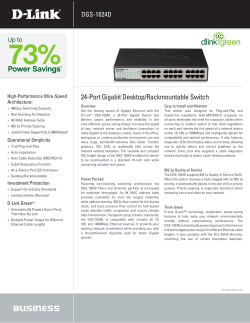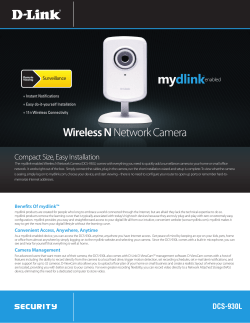
How to Configure Bandwidth Management in DSR Series Configuration Guide Overview
Configuration Guide How to Configure Bandwidth Management in DSR Series Overview This document describes how to configure the D-Link DSR-1000N to enable bandwidth management feature. This feature regulates traffic between the private LAN and external WAN. The screenshots in this document is from firmware version 1.03B12. If you are using an earlier version of the firmware, the screenshots may not be identical to what you see on your browser. How to Configure Bandwidth Management in DSR Series 2 Situation note The bandwidth management feature can be used to guarantee bandwidth for mission critical applications and it can throttle traffic for lower priority and bandwidth consuming usage. With this feature, company can efficiently utilize Internet bandwidth and increase productivity for business. PC1 192.168.10.100 DSR-1000N LAN 192.168.10.1 WAN 1.1.1.1 Internet Configuration Step 1. Under the ADVANCED -> Advanced Network -> Traffic Management -> Bandwidth Profiles, select Enable Bandwidth Profiles and click Save settings. Step 1: Enable Bandwidth Profiles Step2: Save Settings How to Configure Bandwidth Management in DSR Series 2. Click the Add button to create a Bandwidth Profiles. Select the Add button 3. Specify the Name, Profile Type and Minimum Bandwidth Rate, Maximum bandwidth Rate, WAN Interface like as follows and click the Save Settings: 3a. Name: This field is the unique identifier for the profile. 3b. Profile Type: This field is to specify if the profile is a rate controlling profile or a priority controlling profile. Rate control will allow the User to define a minimum and maximum rate in Kbps and the internet pipe line availability is accordingly bounded. For a Priority type profile the exact rate itself is not bounded rather associated traffic is allocated to pre-defined priority segments to ensure available bandwidth is first consumed first by the highest priority segment. 3c. Priority: This is the priority of the traffic to set the bandwidth rate on. Choose from low, medium and high priorities. 3d. Minimum Bandwidth Rate: This field is the minimum bandwidth value in Kbps for the profile 3e. Maximum Bandwidth Rate: This field is the maximum bandwidth value in Kbps for the profile. 3f. WAN Interface: The WAN interface on which the bandwidth limiting profile is to be applied. Choose from Dedicated WAN (WAN1) or Configurable WAN (WAN2). 3 How to Configure Bandwidth Management in DSR Series 4. After click Save Settings, you will see the profiles has been created as figure. 4 How to Configure Bandwidth Management in DSR Series 5 5. Under the ADVANCED->Advanced Network-> Traffic Management ->Traffic Selector, double click it. Click the Traffic Selectors 6. Under the Traffic Selectors, click Add button. How to Configure Bandwidth Management in DSR Series 7. Specify the following fields and click Save Settings 7a. Available Profiles: Select from a list of configured bandwidth profiles upon which to apply the traffic selector criteria. 7b. Service: User can select from a list of pre-defined or custom defined services for the traffic selector rule. Custom services can be defined under Advanced->Firewall->Custom Services. 7c. Traffic Selector Match Type: The match type can be one of the following: IP, MAC address, Port name and Interface. IP Address: If the traffic selector match type is IP, enter the IP address in this field. MAC Address: If the traffic selector match type is MAC address, enter the MAC address in this field for the traffic selector rule. Port Name: The LAN port number/name to apply the traffic selector rule if the match type is Port name. Interface: If the match type is interface, select from the interface number provided in the drop down list. Only LAN and VLAN interfaces are applicable. 6 How to Configure Bandwidth Management in DSR Series 8. After Save setting, it will be looks like the following figure. Testing result and procedure: 1. Use the iperf utility to check that the maximum bandwidth is controlled under 1000Kbps. 7 Visit our website for more information www.dlink.com D-Link, D-Link logo, D-Link sub brand logos and D-Link product trademarks are trademarks or registered trademarks of D-Link Corporation and its subsidiaries. All other third party marks mentioned herein are trademarks of the respective owners. Copyright © 2011 D-Link Corporation. All Rights Reserved.
© Copyright 2025





















